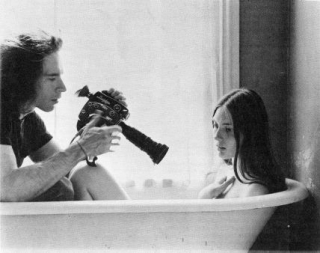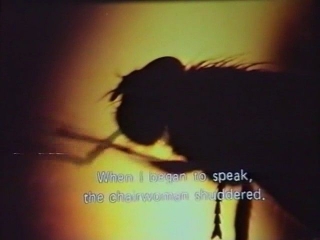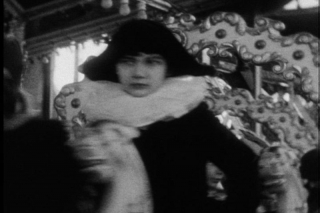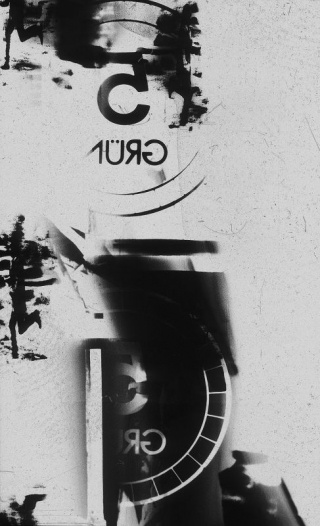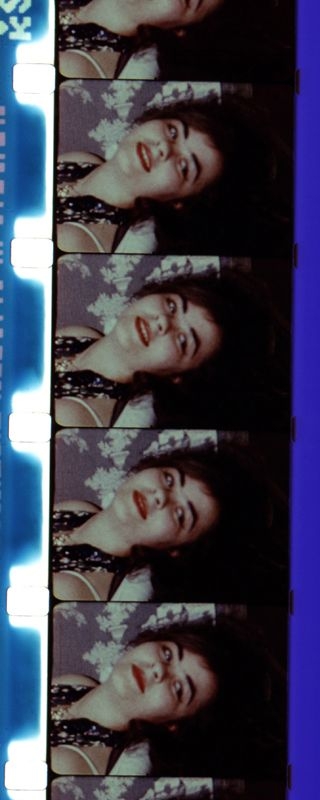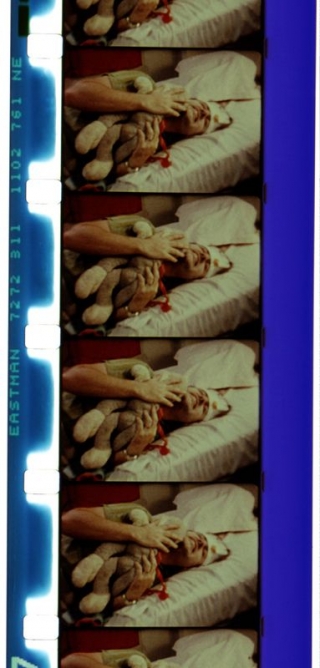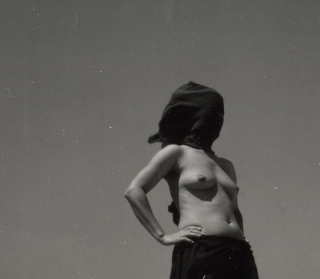Date: 29 October 2005 | Season: London Film Festival 2005 | Tags: London Film Festival
RABBIT PIX
Saturday 29 October 2005, at 7pm
London National Film Theatre NFT3
‘An Italian youth photographs his friends and lovers. Voyeurism drives him and the film.’ (JH)
James Herbert, Rabbit Pix, USA-Italy, 2004, 75 min
An intoxicating chronicle of the romantic liaisons of a group of beautiful young men and women in their Mediterranean idyll. Living in a rundown rural Italian villa, there’s little for them to do but sit around and have sex with each other. A seasoned film-maker, Herbert is paradoxically best known for his pop videos – notably for REM – and many of the sequences in Rabbit Pix, which has only incidental dialogue, are accompanied by music. When the film drifts free of its minimal narrative and escapes into the purely visual, the carnal episodes become stanzas in a lyrical paean to the human form. It’s lush and erotic but never pornographic. That the participants are most often naked and engaged in sexual activity soon becomes secondary to the momentum and fascination created by the tension within the image. Herbert’s signature technique is analytic re-photography: distancing himself from the moment of shooting, he forges an intimate relationship with the material. By selectively cropping the frame, freezing or speeding up motion, he reveals atmospheres and details that are otherwise concealed, conjuring a sensual portrayal of youthful vitality.
Also Screening: Friday 28 October 2005, at 11pm, London NFT3
PROGRAMME NOTES
RABBIT PIX
Saturday 29 October 2005, at 7pm
London National Film Theatre NFT3
“Trust and offerings”
RABBIT PIX
James Herbert, USA-Italy, 2004, 35mm, colour, sound, 75 min
Carter Davis and Maria D’Amato, the couple with French toast, lived in my house. They were lovers. James Taylor, the blond boy lifting stone while in lawn chair (opening), was a painting student of mine. (His parents warned him that I would want to use him in a film … they are artists, former students of mine). Pier Nicola Bruno, the photographer, was in La Presenza (which has never been screened publicly). His girlfriend, at the time we began the film, a Canadian living in Cortona, appears against the tree with a local boy from Cortona, Edouardo Fracasso. The attractive couple seen often, detached and posing, are Alessandro, a former model from Milan home in Cortona, and his then girlfriend Lucia. The juggler is a street performer here. The young boy dropping the glass is an Albanian immigrant we found in a neighbouring town. I have known Coky (P. N. Bruno) for five years and talked him into a film when he saw the interview with me in the Oberhausen Festival catalogue. He has opened up possibilities to use local people … with trust … but I rely on core group of American friends to get the film underway here in Italy. (Language problems etc.)
Carter has appeared in a total of four films and can intuit exactly the right moves on his own, with no direction. I pay the actors, as well as offering room, board, transportation for the Americans. I’m currently working with Maria D’Amato and a Norwegian she met in New York City. Flew him here for the new project. She suggested him and I trust her. He is great. I occasionally will get someone sight unseen but not usually. Most people have exactly the wrong idea of who to select, except kindred spirits Carter and Maria. One time I saw a beautiful German couple visiting Cortona and boldly asked them if I could film them. They were very agreeable. I showed them my book ‘Stills’ to demonstrate some credentials. Once used a kid from a town near Lago di Como and a girl from Florence, a friend of a friend. Good results, as she would not have anything to do with the lower class nude boy. A successful tension. ‘Di Luce in Luce.’ A male renting a room in my house and a female model from the art school. ‘Alcove in the Palazzo Rosso.’ They became lovers.
My partner for seven years appeared in 14 films (two a year). She also helped cast others for her to be with. Once I filmed 10 young friends on a hippie commune outside of Athens, Georgia, for Night Horses. Carter’s best friend, Andy, was flown over here for Speedy Boys. I knew what he looked like as he also lived in my house. Over the years, many people who lived in the house (it averages 13 residents, a southern mansion) have been in various films. Occasionally I use students from the UGA ‘Studies Abroad Program’ – with great care. Scars, girl in Jumbo Aqua, James Taylor in Rabbit Pix. For the females in Speedy Boys I used Carter’s then girlfriend (the only person in clothes, her choice) and two female dancers connected to a local famous modern dance company. I never use theatre or film actors or students of same as their delivery is way too dramatic and over the top for the visual treatment I like. Also I like the flatter delivery non-actors have for my purposes (this is subject to criticism of course).
For a strange selection of models in John Five I used a principle’s lover sight unseen the famous teen gothic novelist, Poppy Z. Brite. She was plump but beautiful and worked well even though out of my canon. I have an elderly couple in Automan. They came with the house in John Five. Willing eccentrics. The lead in Automan was Graham Hacker, who lived in Athens as a town kid. I used him also in Trains with his girlfriend. The white dog was hers.
Automan girl in car was a model in the art school, obtained on the day of shooting as another girl bailed in fear. People are chosen primarily on looks and physical demeanour or affect. The age range is 18 to 26 or so, lean and somewhat free spirited. Usually art kids. It is essential that they not be talking head types disconnected from their bodies. In fact, a definite natural animal grace, a kind or organic movement that is supple and confident. I can tell whether I can use them by how they sit in a chair: brittle or sprawling. I can also usually tell who will trust me and themselves in a vulnerable situation. My new project came up short on one person I riskily thought would be interesting because he was a talking head … but he bailed on hearing the content of the piece.
No directing in the traditional sense. Figures are put into events, or grounds as the painter might say, and only vague notions of content are ever suggested. I would also not direct the placement of a leg, for example, or the explicit gesture of a hand. I just bore the models until they give in to the moment. Or, in contrast, accept the urgency of the one-take sound scene. Scenes in the features are sometimes storyboarded to get people in the right frame of mind. Mostly it’s about getting on my wavelength and rhythm. Carter is amazing at this; that’s why I’ve used him so frequently. Again, most things are one take only – and by financial necessity the 35mm is always one take – without rehearsal because non-actors go too flat if they rehearse.
Only once in Q & A have the subjects of voyeurism or pornography come up, but they come up in interviews frequently. The only time at a screening was for Speedy Boys at Edinburgh. Young-ish guy asks, ‘Is this the first time soft core pornography has been shown at the Edinburgh Film Festival?’ Actually, I told him that down the street they were screening [French female director who specializes in explicit sex scenes] but that I thought pornography could always be differentiated from art because porn was utilitarian and art was useless. I added that I was glad he got hold of the wrong end of a half-truth.
I do use explicitness as another layer or texture because it sits differently in the psychic space and, like violence, gives range to the total orchestration. It also allows for dynamic range in time-based medium. But to me dropping the glass, rubbing the rabbit, hard-on by a tree are all part of the palette and not a reason for the films being. Of course I recognise narrative implications and pushing buttons, but really am most interested in dynamic range tactility, as well as psychically. It’s all well known in long range of the human condition, storytelling, painting. Nobody cares what went on in the Parthenon; we just like the way the building looks.
Nudity is a lifelong fascination but also a voice. I do love the way people change their body language when they are nude: lots of opportunities for interesting motion and twists of limbs etc. that you never witness in the clothed. Then there is the mix of innocence and remotely, (mostly for men I have discovered) threat. Someone drinking a glass of water does it differently nude, believe me. The subtle difference is everything.
In about 50 short films I always shot in 16mm, then re-photographed onto 16mm using primitive hand-operated projectors, one frame at a time in still mode, like slides. Front projection onto a piece of paper 11×14 inches. The features Scars, Speedy Boys and La Presenza were all straight 35mm no re-photography. Jumbo Aqua is the first film to shoot in 16mm and then hand enlarged to 35mm. Rabbit Pix is different still in that all the colour is 16mm hand enlarged to 35mm colour, but the black and white is straight 35mm, no re-photography. Rabbit Pix has about three seconds cannibalised from Jumbo Aqua, not Speedy Boys. That footage is all from another source. But a lot of Rabbit Pix revisits my past work, in attitude, intentionally. I thought of it as an homage to film and grain and analogue before I tried my hand at digital in all its non-plasticity and coldness. That’s what I am currently dealing with in a new piece. So Rabbit Pix may be a kind of ending or coda … but never say die.
(James Herbert, from email discussions with Mark Webber, 2005)
Back to top
Date: 29 October 2005 | Season: London Film Festival 2005 | Tags: London Film Festival
DESOLATION ROW
Saturday 29 October 2005, at 9pm
London National Film Theatre NFT3
Jonathan Schwartz, For Them Ending, USA, 2005, 3 min
A crudely animated bucolic reverie that is undermined by its exaggerated, incongruous soundtrack.
Joell Hallowell & Jacalyn White, Neptune’s Release: A Shot in the Dark, USA, 2004, 17 min
Found footage assembled into a crushing observation of the futility and inevitability of life. Escape into spiritual or hallucinogenic diversions probably won’t help you: lay down all thoughts, surrender to the void.
Louise Bourque, The Bleeding Heart of It (L’eclat du mal), Canada, 2005, 6 min
‘In my dream there’s a war going on. It’s Christmas time. I’m running and I’m carrying myself as a child. It’s dark in the tunnel and I’m heading towards the light, the daylight.’ (LB)
Janie Geiser, Terrace 49, USA, 2004, 6 min
Geiser creates cryptic dreamscapes by mapping video images onto filmic terrain. In Terrace 49, ‘images of impending disaster collide with the image of a woman, who disappears into the texture of the film itself.’ (JG)
Lewis Klahr, The Two Minutes to Zero Trilogy, USA, 2003-04, 33 min
Armed only with four issues of ‘77 Sunset Strip’ comic books, Klahr depicts events building up to a bank heist, literally shaking life into the images. As tension rises and time closes in on the moment of truth, the soundtrack shifts from light 60s psychedelic pop to 80s no wave / avant rock.
Naoyuki Tsuji, Trilogy About Clouds (Mittsu no Kumo), Japan, 2005, 13 min
Gloomy clouds herald mysterious incidents in this exquisite work, whose naïve pencil animation belies its dark meaning.
Christina Battle, Nostalgia (April 2001 to Present), Canada, 2005, 4 min
Fractured memories of an idyllic childhood. Hope springs life eternal.
PROGRAMME NOTES
DESOLATION ROW
Saturday 29 October 2005, at 9pm
London National Film Theatre NFT3
FOR THEM ENDING
Jonathan Schwartz, USA, 2005, 16mm, colour, sound, 3 min
swallowed up in the sky,
the sound sustained by echo, always fading.
the nature of a season,
moving forward with growth or death and growth.
or i was wondering how to make new england fall colours linger so if you couldn’t visit soon
the yellows oranges and reds would still be waiting for you.
(Jonathan Schwarz)
NEPTUNE’S RELEASE: A SHOT IN THE DARK
Joell Hallowell & Jacalyn White, USA, 2004, 16mm, colour, sound, 17 min
In a collage of 16mm found footage and sound, Neptune’s Release: Shot in the Dark is a dialogue between the purveyors of salvation and the seekers, between the past and the present, the hopeful and the hopeless, the humorous and the devastating. In the human search for profound answers to complex questions we are often thrown onto the path of false prophets, indecipherable jargon, bad advice and mixed messages. But as we shoot into the dark, hoping to find a worthy target, we occasionally hit upon accidental wisdom that is surprisingly relevant and life changing. It’s an action-packed film with a star-studded cast. See Janis Joplin tussle with Timothy Leary and Shirley McClaine in a dark alley. “The day it happened was just an ordinary day.” Hear Jack Kornfield perform eye surgery, and watch Zippy the Chimp save the day. Collecting obscure advertisements of the fifties, spiritual audiotapes from the sixties and seventies, obsolete medical films and some of their own editing-bin discards, the filmmakers are a product of this jumble of material. As a consequence they have formed unique connections linking sound and image, dark and light, and the sacred and profane. It’s a 16mm roller coaster ride through time and space – where the end is just the beginning. “You will find the results unusually refreshing.” (Joell Hallowell & Jacalyn White)
L’ECLAT DU MAL
Louise Bourque, Canada, 2005, 35mm, colour, sound, 6 min
We were promised a perfect world growing up. We woke up one day and realized that those vows were little more than wishful thinking. There is a war going on. The memories of our childhood have melted, deteriorated, like the footage of Bourque’s childhood (shot by her father). An oppressively grim vision of innocence lost, of promises unfulfilled. (Ivan Lozano, Cinematexas)
TERRACE 49
Janie Geiser, USA, 2004, 16mm, colour, sound, 6 min
Images of impending disaster – slamming doors, a truck careening down a hill, and a frayed, almost snapping elevator rope – collide with the repeated image of a woman-body, cycling toward ephemerality as the woman disappears into the texture of the film itself. In my recent films, I have been exploring the possibilities found in merging video texture with film, creating a lush, disorienting, ambiguous film space, and an atmosphere of temporal suspension. In Terrace 49, I further break up this space, dividing the film frame into shards, as fractured as memory and as fragile as glass. (Janie Geiser)
TWO MINUTES TO ZERO TRILOGY
Lewis Klahr, USA, 2003-04, 16mm, colour, sound, 33 min
1. Two Days To Zero (2004, 23 min)
2. Two Hours To Zero (2004, 9 min)
3. Two Minutes to Zero (2003, 1 min)
A feature length narrative compressed three different times into three separate films of diminishing duration until the synoptic is synopsized. A crime story told three different ways concerning the events of a two month period leading up to, and immediately following a bank robbery. The imagery has all been appropriated (the fancy, art world sanctioned term for stealing) from four issues of an early 1960s comic book version of the then popular, American TV show ‘77 Sunset Strip’. […] When I first started ‘time travelling’ via collage in my mid-twenties, I naively figured I’d immerse myself, exhaust the impulse by coming to grips with some core revelation about my childhood and get back to describing the present. If someone had told me that more than two decades later I’d still be unpacking that trunk of veils where memory and history intersect and collide, I wouldn’t have believed them (back then I still believed in catharsis). So what exactly has been taking so long? What I underestimated is the degree of difficulty, despite how one pointed my focus has often been, to ‘unpack that trunk’. It’s been a long, slow wind inside, to penetrate collage and experimental film deeply enough to fine tune the empathetic projection required to reach the far shores of memory both lived and imagined. Only now, perhaps aided by the distance of middle age, am I feeling the control and insight to fully engage the found images and sounds that provoked this journey of (re-?) animation in the first place. (Lewis Klahr)
TRILOGY ABOUT CLOUDS
Naoyuki Tsuji, Japan, 2005, 16mm, colour, sound, 13 min
Three short animation films about clouds. It is based in charcoal drawing. The clouds without fixed forms are the worlds which surround us.
1. Breathing Cloud (Eros) (3 min)
People’s bodies and souls transform into a large cloud and are mixed with erotic shapes.
2. Looking at a Cloud (Memory of Childhood) (5 min)
Something happens at the junior high school. When a boy starts to draw a cloud,
the drawing begins to move and eat the students …
3. From the Cloud (Fantasy) (4 min)
A funny little story about people living on the soft cloud. A look at their daily life.
In the morning, they hear the bell and begin to come down from the sky.
(Naoyuki Tsjuji)
NOSTALGIA (APRIL 2001 TO PRESENT)
Christina Battle, Canada, 2005, 16mm, b/w, sound, 4 min
“The picture of the world that’s presented to the public has only the remotest relation to reality.”
(Noam Chomsky)
www.cbattle.com
Back to top
Date: 30 October 2005 | Season: London Film Festival 2005 | Tags: London Film Festival
FILMS BY VLADIMIR TYULKIN
Sunday 30 October 2005, at 2pm
London National Film Theatre NFT3
Vladimir Tyulkin, About Love, Kazakhstan, 2005, 28 min
A portrait of Nina Perebeyeva, who for 30 years has dedicated her life to abandoned and infirm dogs, turning her home into Kazakhstan’s only animal shelter. Dogs are everywhere – constantly barking and bickering – and the house is one big litter tray, but there is such compassion in the chaos. Perebeyeva is almost saintly in her devotion to the animals, and the film’s tender view culminates in the absolute wonder of its life-affirming ending, in which she receives an unexpected gift from the film crew.
Vladimir Tyulkin, Lord of the Flies, Kazakhstan, 1990, 45 min
Lord of the Flies is an incredible glimpse into the life of Kirill Ignatyevich Schpak and his garden of unearthly delights. An outsider by any standards, Grandad Kirill has spent his retirement ‘undermining the fly population’ by killing flies with an almost religious fervour, hoping to prevent contamination by the bacteria they carry. Hard working and well intentioned, his method is inventive but slightly skew. It looks like he’s actually cultivating larvae in his ‘flytrone’ just so that he can destroy it, after which it’s preserved as feed for the chickens. ‘It gives me free meat and eggs. If such farms are set up all over the country, we’ll enter a new era of prosperity’. He admits his efforts are futile unless his pest control plan is implemented worldwide, and his self-sufficiency doesn’t entirely provide for his citizens: he buys canine corpses from the dogcatcher and boils up the meat – disguising the taste with stewed aubergines – to feed to his hounds. This self-styled tsar enforces strict law and order and has no time for perestroika; his backyard is a ‘state in miniature’ in which nations of animals live in communal harmony. Kirill addresses the camera with crazy schemes and proclamations, and the camera spins off into inspired observations of the world he has created. The visionary cinematography and autumnal colours make the film look like an apparition from Hieronymus Bosch, perfectly apt for this extreme, medieval lifestyle.
PROGRAMME NOTES
FILMS BY VLADIMIR TYULKIN
Sunday 30 October 2005, at 2pm
London National Film Theatre NFT3
ABOUT LOVE
Vladimir Tyulkin, Kazakhstan, 2005, video, colour, sound, 28 min
A portrait of Nina Perebeyeva, who for 30 years has dedicated her life to abandoned and infirm dogs, turning her home into Kazakhstan’s first and only animal shelter. Dogs are everywhere – constantly barking and bickering – and the house is one big litter tray, but there is such compassion in the chaos. Perebeyeva graduated from the conservatoire, but her piano has long been abandoned. She now sings in the church choir and is almost saintly in her devotion to the animals, taking care of between 50 to 120 dogs on a small salary of 40 dollars. This tender film culminates in the absolute wonder of its life-affirming ending, in which she receives an unexpected gift from the film crew. (Mark Webber)
LORD OF THE FLIES
Vladimir Tyulkin, Kazakhstan, 1990, 35mm, colour, sound, 45 min
Vladimir Tyulkin’s 42-minute epic documentary Lord of the Flies introduced Kirill Ignatjewich Spack, a wild-haired post-Soviet farm hermit who’d developed a complete self-sustaining animal ecosystem involving the farming of flies to produce maggot-feed for his animals, who one by one became the meat traps to lure in the flies. A Russian tyrant in miniature – the Stalin of his bestial gulag – he talked Tyulkin calmly through his mad methods and morals, and commended his system to Mikhail Gorbachev for national rollout. This animal kingdom seemed to have regressed to the Hobbesian idea of the state of nature: nasty, brutish and short. (Nick Bradshaw)
Lord of the Flies belongs to the literary tradition of Jules Vernes’ tale ‘Two Years Holidays’, in which he describes schoolboys who bring into being a rationality-based, ideal world after being stranded from a shipwreck. William Golding’s story, ‘Lord of the Flies’ from 1954 takes up the motif of the stranded children, but sketches far more realistically, the development of despotism in miniature format. The figure of the fly killer in Tyulkin’s film possesses many aspects: as the post-communist version of the hippie dropout, he symbolises the improvised gardening at a datscha, a way in which many Soviet citizens ensured their survival after perestroika at a primitive level. He sways back and forth between the caricature of new entrepreneurship – after all, he has managed to construct an own economic circulation on his land – and the incarnation of the last Stalinists, who are still obsessed with ridding the world of their enemies. Flies have, furthermore, a long tradition in Soviet iconography: their larvae in canteen meat are the trigger of the revolution in Battleship Potemkin, symbolic of the rotten system of the Czar, a metaphor for the later, no less degenerated Soviet system, described in the works of Ilya Kabakov. At the same time flies have always been seen as a worthless life form because of the sheer masses in which they appear and because of their short lifespan, which refers to the Gulag in its purposeful annihilation, but also refers to their ideal disposition as material for scientific experiments, just as the Soviet person in the socialist experiment. The film achieves a particular topicality not only due to the war in Chechnya with its undisguised purge terminology, but also of genetic technology, which began with flies and is now being advanced to human beings. (Craig Venter is, since his decoding of the Drosophila Genome also termed “the Lord of the Flies”.) And, it is actually so, that the notion of the New Human Being is enjoying its resurrection through genetic technology. (Marcel Schwierin)
Back to top
Date: 30 October 2005 | Season: London Film Festival 2005 | Tags: London Film Festival
HISTORY AS SHE IS HARPED
Sunday 30 October 2005, at 4pm
London National Film Theatre NFT3
Leslie Thornton, Let Me Count The Ways: Minus 10, 9, 8, 7, USA, 2004, 20 min
A meditation on the bombing of Hiroshima, matching found footage with revealing audio interviews with survivors, and informed by the film-maker’s personal connection to the horrific event. It opens with amateur movies of Thornton’s father (a nuclear physicist who worked on the Manhattan Project) at the Los Alamos Air Base. Later sections concern the effects on vegetation in the devastated region.
Jayne Parker, Stationary Music, UK, 2005, 15 min
Poetic record of ‘Sonata 1’ (1925) by modernist composer Stefan Wolpe – a Jewish communist who was forced to flee Germany in 1933, ultimately making the transition from the Bauhaus to Black Mountain College. An appropriately still and empathetic camera captures this vibrant solo piano performance by his daughter Katerina, who first recounts some of the history of the piece.
Abigail Child, The Future Is Behind You, USA, 2004, 16 min
Fictional biography woven around home movie footage shot by an anonymous German family in the 1930s. The relationship of two adolescent sisters, and how it may have been affected by the turbulent times ahead, is the focus of a work that raises questions about the interpretation of personal and public histories.
Deborah Stratman, Energy Country, USA, 2003, 15 min
Stratman’s impressionistic essay on the oil industry implicitly refers to ulterior motives behind the invasion of Iraq. The dreamlike tour of petrochemical sites in Southern Texas contrasts with the harsh realities of Christian fundamentalist attitudes to homeland security that are heard on the soundtrack.
Fréderic Moser & Philippe Schwinger, Capitulation Project, Germany-Switzerland, 2003, 21 min
What at first looks to be historical footage of the Performance Group’s ‘Commune’ (1971) – a stark work of environmental theatre about the My Lai massacre – is in fact a carefully re-staged interpretation featuring German actors. Its apparent authenticity, which reflects the Group’s constant shifting between performance, improvisation and rehearsal, oscillates the viewer’s concentration between the various levels of reality it presents.
PROGRAMME NOTES
LET ME COUNT THE WAYS: MINUS 10, 9, 8, 7
Leslie Thornton, USA, 2004, video, b/w, sound, 20 min
Let Me Count the Ways is an ongoing serial about violent terror and its aftermath. In episodes Minus 10, 9, 8, and 7, personal reminiscence is mixed with archival and new footage in an exploration of the interior of fear. From footage of the artist’s father on the way to Hiroshima, through reference to 9/11, the phenomenology of horror and the echo of its rupture are presented with an intensity which moves the viewer from history to the present and beyond. (Leslie Thornton)
STATIONARY MUSIC
Jayne Parker, UK, 2005, video, b/w, sound, 15 min
Stationary Music takes its name from the first movement of Stefan Wolpe’s ‘Sonata 1’ composed in 1925. The sonata is introduced and performed by his daughter, pianist Katharina Wolpe. Stationary Music: music that doesn’t develop/music that stands still.
(Jayne Parker)
after the fire what Shall we do?
“firsT
onE step;
aFter
thAt,
aNother.”
We’re
alOne
the music is difficuLt
to Play.
wE must work at it.
In Memoriam S. W., acrostic by John Cage
THE FUTURE IS BEHIND YOU
Abigail Child, USA, 2004, video, b/w, sound, 16 min
Music by John Zorn, arranged and played by Sylvie Courvoisier and Mark Feldman. The Future is Behind You creates a fictional story composed from an anonymous family archive from 1930s Europe, reconstructed to emphasize gender acculturation in two sisters who play, race, fight, kiss and grow up together under a shadow of oncoming history. I am looking, as always in found material, for the story below the story. Here there are at least three levels: 1) the home movie in which a family from 1930s Germany near the Swiss border poses for the camera, preternaturally happy. Unusually, the mother is main cinematographer; 2) the historical moment which remains as text trace, undermining the image and serving as covert motive for the action; 3) the development of gender identities – the innocent freedom of the elder transformed into socially bruised ‘bride’, the irrepressibility of the younger moving from tomboy to awkward, diffident adult. At once biography and fiction, history and psychology, The Future is Behind You excavates gestures to explore the speculative seduction of narrative; it seeks a bridge between private and public histories. (Abigail Child)
www.abigailchild.com
ENERGY COUNTRY
Deborah Stratman, USA, 2003, video, colour, sound, 15 min
The frenzied detritus of trading floors, smart weaponry and the religious right are woven through the petrochemical landscapes of Southeast Texas. This short video harangue questions land use policy as it serves the oil industry, patriotism as it absolves foreign aggression, and fundamentalism as it calcifies thinking. (Deborah Stratman)
www.pythagorasfilm.com
CAPITULATION PROJECT
Frédéric Moser & Philippe Schwinger, Germany-Switzerland, 2003, video, b/w, sound, 21 min
The New York-based Performance Group staged their piece ‘Commune’ for the first time in February 1971. The play included a short scene referring to the My Lai massacre. If members of the audience refused to participate actively in what was happening on stage during this scene, the actors interrupted their performance – sometimes for as long as three hours, depending on the audience’s reaction. The group experimented with several variations of the scene. Starting with photographs of the performance and the notes of Richard Schechner, the theorist of environmental theatre, we came up with a new version of the My Lai sequence. We worked with the statements of soldiers involved in the massacre, criminal investigation reports, and contemporary articles in the press. In the process, we developed a scenario that enabled us to translate the historical documents into a form suitable for the stage. We aimed at representing an event of war without using any of the film industry’s spectacular devices. What means do we have, as individual citizens, to come to terms with an act of terror? We followed the trail of the Performance Group. Their attempt to create a platform for self-criticism within the context of a theatre performance motivated our dramatic intentions. For this we reconstructed the stage set of ‘Commune’: a wave, evoking a landscape and also functioning as an agora, and scaffolding around the stage with seating for the audience. In 1971 the performers were inspired by rituals: they danced and they sang. We did not attempt to re-create this authenticity in our production. Although we do evoke the symbolic level of their representation, we chose to develop our play with the actors on two different levels. Each of the performers takes on a function, for example, as a reporter, but they can also intervene at any time in their own name. Thus, there is a constant back and forth between the actors and the characters they are representing. This method of dramatic framing enabled us to establish an analogy with film. There is no live performance in Capitulation Project. The scene was filmed in about 30 sequences during two night shoots, with extras as a ‘fake’ audience. The distance from the performance that is created through the process of filming is comparable to our detachment from current political events. We intentionally moved back a few steps in time. We evoked the massacre by means of a contemporaneous artistic form in order to demonstrate that the grasp of an event of war is coupled with its transmission. (Frédéric Moser and Philippe Schwinger)
Back to top
Date: 30 October 2005 | Season: London Film Festival 2005 | Tags: London Film Festival
THE HEART OF THE MATTER
Sunday 30 October 2005, at 9pm
London National Film Theatre NFT3
Karen Mirza & Brad Butler, The Space Between, UK, 2005, 12 min
Time and space shattered into shards of light. Footage shot in India and thoroughly reworked in the optical printer into a rigorous, flickering duality.
Peter Tscherkassky, Instructions for a Light and Sound Machine, Austria, 2005, 17 min
Torment on the editing table: a Hollywood western persecuted by the brutal mechanics of the cinematic. A ruthless duel between character and conduit, played out to the death.
Daïchi Saïto, Chasmic Dance, Canada, 2004, 6 min
An expression of primal rhythmic energy that synthesises high-contrast film stock with exaggerated video raster lines.
Fred Worden, Blue Pole(s), USA, 2005, 20 min
Worden finds a digital outlet for the research into visual phenomena pursued in his films, creating one of the most startling abstract works of recent years. Video signal as constellation of light, piercing a cosmos of noetic possibilities. Its soundtrack is the equally mesmerising ‘London Fix’ by Tom Hamilton, an electronic composition based on the fluctuating price of gold. This strange brew is visual voodoo of the highest order.
Michael Robinson, You Don’t Bring Me Flowers, USA, 2005, 8 min
Powerful ecological omen composed of centrefold landscapes from National Geographic magazine. The seam down the centre of the images suggests the fractures caused by our reckless treatment of the planet.
Trish van Huesen, Fugue, USA, 2004, 7 min
‘Inspired by musical and psychological definitions, Fugue examines the dark flight from identity and environment. Hand processing and the juxtaposition of positive and negative footage depict the journey of a woman as she shifts between being black or white widow or bride.’ (TvH)
PROGRAMME NOTES
THE HEART OF THE MATTER
Sunday 30 October 2005, at 9pm
London National Film Theatre NFT3
THE SPACE BETWEEN
Karen Mirza & Brad Butler, UK, 2005, 16mm, colour, silent, 12 min
The Space Between tackles the context of the recycled image. Exploring the space between frames and within frames, conventional photographic representation gradually metamorphoses into abstract patterns of pulsing coloured light. What begins as an image of looking at (and through) a high-rise building offers viewers an opportunity to experience shifting relationships between perception and cognition, from realism to painterly abstraction. (Karen Mirza & Brad Butler)
www.mirza-butler.net
INSTRUCTIONS FOR A LIGHT AND SOUND MACHINE
Peter Tscherkassky, Austria, 2005, 35mm, b/w, sound, 17 min
The hero of Instructions for a Light and Sound Machine is easy to identify. Walking down the street unknowingly, he suddenly realizes that he is not only subject to the gruesome moods of several spectators but also at the mercy of the filmmaker. He defends himself heroically, but is condemned to the gallows, where he dies a filmic death through a tearing of the film itself. Our hero then descends into Hades, the realm of shadows. Here, in the underground of cinematography, he encounters innumerable printing instructions, the means whereby the existence of every filmic image is made possible. In other words, our hero encounters the conditions of his own possibility, the conditions of his very existence as a filmic shadow. Instructions for a Light and Sound Machine is an attempt to transform a Roman Western into a Greek tragedy. (Peter Tscherkassky)
www.tscherkassky.at
CHASMIC DANCE
Daïchi Saïto, Canada 2004, 16mm, b/w, silent, 6 min
A visual metaphor for the creative process as a sustained state of flux, whereby the deconstruction and reconfiguration of source material manifest themselves as a series of rapid abstract movements. Alluding to the cosmic dance of Shiva, the film is an expression of primal rhythmic energy, moving dialectically but without sublimation. Regeneration ignites destruction, and transformation invites mutation, through clashes of opposing modes such as video/film, surface/depth, and light/darkness. The original materials used in the film were images of the human body shot on 16mm film; they were modified through accidental processes in video transfer, and the resulting images were re-filmed back on 16mm, passing through multiple stages of printing on a modified Steenbeck. The film was hand-processed, optically printed and contact printed by the filmmaker. (Daichi Saito)
BLUE POLE(S)
Fred Worden, USA, 2005, video, colour, sound, 20 min
For 25 years I’ve been interested in an optical/perceptual cinema. A cinema where the eye is called out from its routine and autonomic operations and is challenged to make sense of stimuli coming not from the natural world out in front of the eyes, but rather from a source behind the eyes, the conscious mind. A kind of feedback loop in which the conscious mind employs the seductive powers of cinema to seed the perceptual mind with curiosity and imagination, qualities not native to perception. Blue Pole(s) tries hard to up the ante on the notion that film is a visual rather than literary art and that seeing as a perceptual process precedes and models thought. Music by Tom Hamilton. (Fred Worden)
YOU DON’T BRING ME FLOWERS
Michael Robinson, USA, 2005, 16mm, colour, sound, 8 min
Viewed at its seams, a collection of National Geographic landscapes from the 1960s and 1970s conjure an extinct American romanticism currently peddled to propagate entitlement and bigoted individualism from sea to shining sea; the slideshow deforms into a bright white distress signal. (Michael Robinson)
www.poisonberries.net
FUGUE
Trish van Huesen, USA, 2004, 16mm, colour, sound, 7 min
This film, as with all of my work, is an exploration of change. It was a difficult film for me to make. I was living in the United States, and all of the horror, fear and nationalistic fanaticism after September 11th began to permeate my consciousness. The heroine of the film, as she began her descent, started to look as much like the image of a country as the image of a human being. During the editing process, as America dropped bombs on Iraq, I could not seem to get her out of “hell”, and then suddenly, just as a thunder storm strikes and then passes, the darkness broke and she ascended again. It was the collaboration with my partner in sound, Eyvind Kang, and his co-creators, which actually broke the darkness and facilitated her ascension. We were all affected by what was happening in America, but I was creating from the darkness, and they were more able to create from the light. Eyvind’s choice of ‘Emblem 50’ of Michael Maier’s fugal works, as a starting point for the soundtrack, woke me up to the reality out of which I had been creating. The result is a black and white film which examines Darkness as the partner of Light. (Trish Van Huesen)
Back to top
Date: 31 March 2006 | Season: London Lesbian & Gay Film Festival 2006 | Tags: London Lesbian & Gay Film Festival
IN LUST WE TRUST: 8MM FILMS BY THE KUCHAR BROTHERS
Friday 31 March 2006, at 6:30pm
London Lesbian & Gay Film Festival at BFI Southbank
KUCHAR BROTHERS: PROGRAMME ONE
George Kuchar, Sylvia’s Promise, USA, 1962, 9 min
Love comes in all sizes. But the bonds of love extract a terrible price to be paid in flesh.
Mike Kuchar, Born of the Wind, USA, 1962, 24 min
‘A tender and realistic story of a scientist who falls for the mummy he restored to life. 2,000 years as a mummy couldn’t quench her thirst for love!’ GK
George Kuchar, The Thief and the Stripper, USA, 1959, 25 min
An unlikely ménage à trois, doomed to end in a tornado of wanton violence.
George Kuchar, A Town Called Tempest, USA, 1963, 33 min
‘What happened that afternoon that left a town in shambles, its people in search of God?’ GK
PROGRAMME NOTES
IN LUST WE TRUST: 8MM FILMS BY THE KUCHAR BROTHERS
PROGRAMME 1
Friday 31 March 2006, at 6:30pm
London Lesbian & Gay Film Festival at BFI Southbank
SYLVIA’S PROMISE
George Kuchar, USA, 1962, 8mm on 16mm, colour, sound, 9 min
‘Love comes in all sizes. But the bonds of love extract a terrible price to be paid in flesh. A vow weighs heavily on the heart. Sylvia makes a promise but can she keep it ?’ (George Kuchar)
BORN OF THE WIND
Mike Kuchar, USA, 1962, 8mm on 16mm, colour, sound, 24 min
Donna Kerness and Bob Cowan, whose torrid off-screen romance caused a sensation in the steam room of the St. George Hotel, are teamed for the first time in this poignant film of shriveled beauty and bloodless vengeance. Mr. Cowan is a striking performer resembling a vulture with shoestrings on its head. He and the buxom Miss Kerness battle front and center in the biggest clash of the hams since Godzilla and King Kong, and it’s one of the mysteries of gravity that Kerness doesn’t flop on her face, she being so top-heavy.
‘A tender and realistic story of a scientist who falls in love with a mummy he has restored to life … 2,000 years as a mummy couldn’t quench her thirst for love!’ (George Kuchar)
THE THIEF AND THE STRIPPER
George Kuchar, USA, 1959, 8mm on 16mm, colour, sound, 25 min
Three years to complete … It dares to lay bare the naked carcass of a generation gone mad with moral decay. Starring Tony Reynolds and Candy Newman in the film that got them married!
‘An early film, depicting today’s youth … raw and brutal.’ (George Kuchar)
A TOWN CALLED TEMPEST
George Kuchar, USA, 1963, 8mm on 16mm, colour, sound, 33 min
Rarely has the cinema equaled such spectacle! Seldom have movies probed so deeply in the rotten core of hypocrisy and weakness! Only the talents of Larry Leibowitz and Zelda Kaiser, his cousin from Hawaii, could make this tale of hatred and fanaticism come alive from the screen and hit you in the face with truth.
‘What happened that afternoon that left a town in shambles, its people in search of God?’ (George Kuchar)
Back to top
DOWNLOADS
LINKS
www.llgff.org.uk
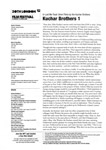
Programme Notes PDF 2.1 MB

Programme Notes 2.1 MB
Date: 2 April 2006 | Season: London Lesbian & Gay Film Festival 2006 | Tags: London Lesbian & Gay Film Festival
IN LUST WE TRUST: 8MM FILMS BY THE KUCHAR BROTHERS
Sunday 2 April 2006, at 4:15pm
London Lesbian & Gay Film Festival at BFI Southbank
KUCHAR BROTHERS: PROGRAMME TWO
George Kuchar, A Woman Distressed, USA, 1962, 12 min
Her destiny is to be condemned to an insane asylum, where the staff are as crazy as the inmates.
Mike Kuchar, Night Of The Bomb, USA, 1962, 18 min
Only the chaos of an atomic blast can interrupt the erotic mission of these Cold War kids.
Mike Kuchar, The Confessions Of Babette, USA, 1963, 15 min
How much depravity can one woman crave?
George Kuchar, Anita Needs Me, USA, 1963, 16 min
‘All the horrors and guilt of the human mind exposed! Your emotions will be squeezed.’ GK
Mike & George Kuchar, I Was A Teenage Rumpot, USA, 1960, 10 min
‘A documentary about people like you and me, people with a zest for life.’ GK
Mike & George Kuchar, The Slasher, USA, 1958, 21 min
An insane killer stalks the grounds of a resort house, bringing sudden violence to those of easy virtue and godlessness.
PROGRAMME NOTES
IN LUST WE TRUST: 8MM FILMS BY THE KUCHAR BROTHERS
PROGRAMME 2
Sunday 2 April 2006, at 4:15pm
London Lesbian & Gay Film Festival at BFI Southbank
A WOMAN DISTRESSED
George Kuchar, USA, 1962, 8mm on 16mm, colour, sound, 12 min
‘The movie club put out a newsletter and one of my early 8mm films, A Woman Distressed, was the only picture that they ever panned in the pages of their cinematic rag. The film was a brash, reckless, comic-drama about the drug Thalidomide and its deforming effect upon the offspring of a big-city maternity ward. Stories of the horrors caused by the drug were permeating the newspapers at the time and I used the reported material as a basis for the comic-drama (or dramedy as it is now called by prime-time practitioners of the TV medium). ’ (George Kuchar)
NIGHT OF THE BOMB
Mike Kuchar, USA, 1962, 8mm on 16mm, colour, sound, 18 min
Teenage lust and deranged delinquence combine to create a cautionary tale for the ages. The Chernobyl of Comedy!
‘The bomb in Night of the Bomb was a vehicle to use as a spectacular image – people in conflict – otherwise it’s hard to make a narrative if something drastic doesn’t happen.’ (Mike Kuchar)
THE CONFESSIONS OF BABETTE
Mike Kuchar, USA, 1963, 8mm on 16mm, colour, sound, 15 min
Following on the heels of Powell’s Peeping Tom, it almost matches that film classic in progressing truly disturbing psychological horror in contemporary cinema. (www.imdb.com)
ANITA NEEDS ME
George Kuchar, USA, 1963, 8mm on 16mm, colour, sound, 16 min
‘As one man learns of another man’s troubled relationship, he understands how to handle his own troubles at home. The only film to have any dialogue, this tale of tragedy and the scars it leaves on the human psyche is wonderfully told through a voice-over monologue that dives into the deepest shades purple prose.’ (Ryan Sarnowski)
‘All the horrors and guilt of the human mind exposed! It reaches deep into the workings of a woman’s cravings. Your emotions will be squeezed.’ (George Kuchar)
I WAS A TEENAGE RUMPOT
Mike & George Kuchar, USA, 1960, 8mm on 16mm, colour, sound, 10 min
With the birth of I Was A Teenage Rumpot, George and Mike Kuchar stumbled upon something big: their names were Arline, Edie, and Harry. Sensing the tremendous physical potential embedded in this trio’s glands, plans were immediately drawn up to star them in two new films: The Flesh Is Plentiful and Butterball 8. Arline and Harry’s divorce shattered all future films and Arline went on a drunken binge which ended with her head being shaved by a French woman on grounds of ‘husband-stealing’.
‘A documentary about people like you and me, people with a zest for life.’ (George Kuchar)
THE SLASHER
Mike & George Kuchar, USA, 1958, 8mm on 16mm, colour, sound, 21 min
‘An insane killer stalks the grounds of a resort house, bringing sudden violence to those of easy virtue and godlessness.’ (George Kuchar)
Back to top
DOWNLOADS
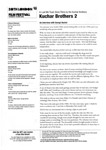
Programme Notes PDF, 2.1 MB
Date: 6 May 2006 | Season: Robert Nelson
ROBERT NELSON: RAN WITH THE MOVIE CAMERA 3
Saturday 6 May 2006, at 7pm
International Short Film Festival Oberhausen
Robert Nelson, Deep Westurn, USA, 1974, 16mm, 6 min
Preserved by the Academy Film Archive
A ‘film wake’ for a friend who gave free dental care in exchange for artwork. (MW)
“Though celebratory in mood, it has a mournful subtext … death and dying. We dedicated it to Dr. Sam West, departed friend and patron of the arts, trusting that his ghost would approve our hijinx and seeming irreverence.” (RAN)
Robert Nelson, Special Warning, USA, 1974/1999, 16mm, 8 min
“Special Warning is like a poem more than a narrative or story. It suggests states of isolation, barrenness, sexual guilt and sin, but even these punishing afflictions can have a humorous aspect when accompanied by horns.” (RAN)
Robert Nelson, More, USA, 1971/2000, 16mm, 20 min
Two complete sections from the 70-minute film No-More which Nelson produced with students at a summer school in Ithaca, NY. Shot in a verité style, they show a baseball game between hippies and straights, and the stoned and drunken party that follows as the kids hit the streets that evening. (MW)
Robert Nelson, Hauling Toto Big, USA, 1997, 16mm, 43 min
“Hauling Toto Big operates on so many levels and points to so many different traditions of the avant-garde that it could serve as a compendium of style and theme, while also bearing Nelson’s particular stamp and trickster persona. It’s too bad his work is so rarely seen – it’s some of the most irreverent, unpretentious, and loving work I’ve ever laid eyes on.” (Michael Joshua Rowin)
“This is my best film. This one cuts the deepest. Upon this one I stand or fall. Better yet the larger one comprised of all.” (RAN)
Date: 19 May 2006 | Season: Wilhelm Hein
WILHELM HEIN: PERFEKT!
19—20 May 2006
London The Horse Hospital and Goethe Institute
Undeniably one of the major figures of European personal filmmaking, Wilhelm Hein makes a rare visit to London to present three programmes at the Goethe Institute and Horse Hospital.
Wilhelm Hein began filmmaking (together with Birgit Hein) in the late 1960s, creating highly original collages such as Rohfilm (1968). In these rough, visual attacks, the film material affirms its presence on the screen rather than acting simply as a transparent carrier for photographic images. This style of Materialist filmmaking developed in parallel at the London Filmmakers’ Cooperative, leading to early links between the avant-garde in Germany and the UK.
W+B Hein were also innovators in the fields of multi-screen projection and live film performances, with works including Doppelprojektion (1971) and Superman and Wonderwoman (1980-84). Tireless promoters of work by others, they organised XSCREEN in Cologne (1968-71) to present regular programming, made documentaries for WDR television, and were largely responsible for establishing a presence for avant-garde cinema in European art museums and surveys (such as Documenta) in the 1970s.
Despite this activity and recognition, Wilhelm Hein has resisted becoming part of the establishment. He remains committed to the vitality of the underground and prefers punk clubs to professorships. A survivor with a restless energy, Hein is one of the last true radicals of his generation, continuing with a subversive practice dedicated to the freedom of expression.
Curated by Mark Webber for Goethe-Institut London.
Back to top
Date: 19 May 2006 | Season: Wilhelm Hein
YOU KILLED THE UNDERGROUND FILM
Friday 19 May 2006, at 7:30pm
London The Horse Hospital
“Wilhelm Hein: Perfekt!” begins with a screening (at the Horse Hospital) of his recent epic, You Killed The Underground Film, or The Real Meaning of Kunst Bleibt, Bleibt. An open-ended work, it gathers a decade of footage in a diaristic odyssey that slides from the sublime to the ridiculous, between document and performance.
Hein faces his own history in the climate of political change that has transformed Europe since the 1980s, mixing images with diverse music and spoken word recordings. Jack Smith, Nick Zedd and other underground figures appear in the film, which transcends nostalgia to become a pure and progressive affirmation of independence. Defiant, didactic and polemical, this sprawling opus is a kick in the teeth for convention. (Against all odds, it won the German Critics Prize at last year’s European Media Art Festival, Osnabrück.)
Wilhelm Hein, You Killed The Underground Film, or The Real Meaning of Kunst Bleibt, Bleibt Germany, 2002-06, b/w & colour, sound-on-cd, 120 min
“Wilhelm Hein’s new film is a fascinating and challenging example of what it means to make politically relevant underground film in an increasingly rented world.” (Marc Siegel)
Curated by Mark Webber for Goethe-Institut London.
WILHELM HEIN: PERFEKT! continues at the Goethe Institute (South Kensington) on Saturday 20 May. 4pm: Wilhelm Hein & Malcolm Le Grice screening and informal discussion on Materialist filmmaking in the 60s & 70s. 7:30pm: Wilhelm Hein’s Secret Cabinet including films by Andy Warhol, Kurt Kren, Dieter Roth, Tony Conrad, Peter Weibel, Viennese Aktionists Gunther Brus and Otto Muehl, and from the German underground: Annette Frick, Die Tödliche Doris and Lukas Schmied.
PROGRAMME NOTES
YOU KILLED THE UNDERGROUND FILM
Friday 19 May 2006, at 7:30pm
London The Horse Hospital
Wilhelm Hein, punk pioneer of the German underground, presents You Killed The Underground Film, or The Real Meaning of Kunst Bleibt, Bleibt, a diaristic odyssey that slides from the sublime to the ridiculous, between document and performance. Jack Smith, Nick Zedd and others appear in the film, which transcends nostalgia to become a pure and progressive affirmation of independence. Defiant, didactic and polemical, this sprawling opus is a kick in the teeth for convention.
Hein began filmmaking in the 1960s, with rough collages that were audio-visual assaults on the senses. A true radical, who has resisted become part of the establishment, Wilhelm Hein remains committed to the underground and maintains a subversive practice dedicated to the freedom of expression.
YOU KILLED THE UNDERGROUND FILM, OR THE REAL MEANING OF KUNST BLEIBT, BLEIBT
Wilhelm Hein, Germany, 2002-06, b/w & colour, sound-on-cd, 120 min
“Assembled from over 10 years of footage he shot and collected, Wilhelm Hein’s new film is a fascinating and challenging example of what it means to make politically relevant underground film in an increasingly rented world. The film’s title is partly taken from a text of a performance by Jack Smith at the 1974 Cologne Art Fair that Hein documented and uses here in the film’s prologue. On the soundtrack we hear Smith’s familiar, almost comforting, nasaldrone bemoaning museums, the art market and artists whose images suck the life out of their subjects, and the thinning of art. Images of Hein next to various public sculptures and monuments in Poland, the Ukraine, and Russia accompany parts of Smith’s rant. In this sequence, as in many others (for instance, the witty nod to Andrew Warhola set in Warsaw and scored with A Night In Tunisia), Hein’s unexpected combination of sound and image, of references and citations, calls to mind what might be one of the film’s central concerns: what can underground film tell us about the changes in Eastern Europe over the past 15 years? Hein’s révue-like film demonstrates the relevance of asking the question while offering numerous ways of answering it. The film functions as a burlesque show of aesthetic strategies and possibilities, invoking either directly or indirectly a mix of Hein’s favourites, including Marcel Duchamp, George Grosz, Nick Zedd, Arnold Schoenberg, Derek Jarman, Kurt Kren, Jerry Tartaglia, Samuel Beckett, Pete Seeger, Jack Smith, Andy Warhol and many more. Hein never slips into a mode of irony or cynicism while poignantly and beautifully juxtaposing an earnest humanitarian Michael Jackson song with some re-edited Japanese porn. With his sexy, playful and contemplative film, Hein asks of the underground what Jack Smith asked of Maria Montez: give socialist answers to a rented world!” (Marc Siegel)
Back to top
